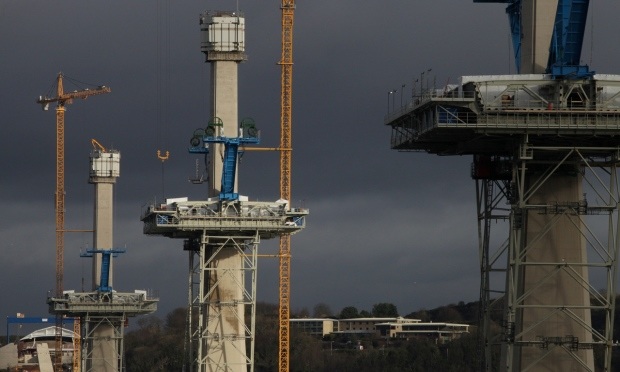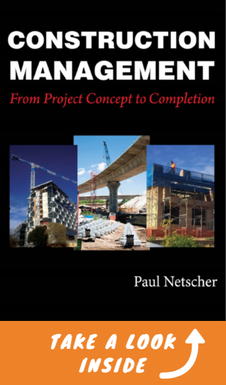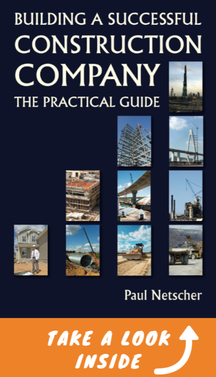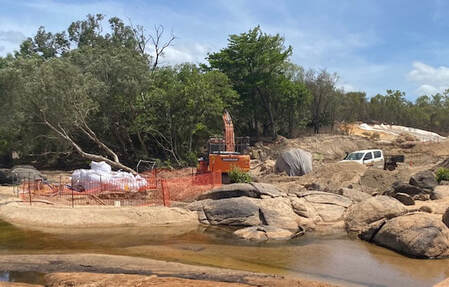"Another construction project completed without any mishaps!" I always thought the best time on a construction project was at the end, when you were loading your equipment onto trucks and sending it to another project, the company yard, or back to the supplier. Wow, another construction project completed without any mishaps! Job satisfaction! You could breathe a sigh of relief. Relax at last. Recently I wondered what gave me job satisfaction and what I was most thankful for at the end of my construction projects. Here are some thoughts: Knowing your construction project was a success
"A project with a death or serious injury will be remembered for the wrong reasons for the rest of your career."
"Good quality work is something that I am always proud of."
"I found deep satisfaction in the success of my team." Completing construction projects successfully
"Don’t you hate those projects that never seem to end?"
There are different reasons to be thankful for at the end of a construction project. What were you thankful for at the end of your last project? What will you be thankful for at the end of your current project? Are you taking steps to ensure this happy satisfied ending? This article was first published on the ClockShark website - Get The Industries' #1 Time-Tracking AppRunning a field service or construction business takes coordination and a great team. With ClockShark you get the industries' #1 timesheet app Do you want to learn how to manage construction projects successfully"A practical and really helpful guide to navigating the myriad of things to think about when managing a construction project." Reader review on Amazon Paul Netscher has written several easy to read books for owners, contractors, construction managers, construction supervisors and foremen. They cover all aspects of construction management and are filled with tips and insights.
Visit to read more. The books are available in paper and ebook from most online stores including Amazon.
0 Comments
"Construction is a risky business. Some projects are riskier than others. We need to understand the risks" Last week I published an article ‘Construction risk and the haunted house’. I mentioned that some contractors see risks everywhere, adding in contingencies for every possible event, while other contractors rush blindly into projects without seeing and allowing for risks that should easily have been foreseen. I recommended contractors fully understand the project and conditions pertaining to it while pricing it, then prepare a schedule of all the potential risks and grade them as to the likeliness of the event happening and also rate the risk’s potential impact. Not all projects are alike and simply adding a standard contingency to your project schedule and project price may make your project too expensive for your customer, or result in you losing money when things go wrong. In doing this we need to rely on our experience and understand how often a particular risk has eventuated. In this article we’ll look at the risk schedule in a little more detail and how we can deal with risks. How to deal with risks on construction projects"Decide the best way to deal with project risks" Once we have our risk schedule we can decide how we should deal with the risks. 1. We can ignore the risks if their impact is low or the likelihood of the event happening is low. I used the example of flying where there are catastrophic plane accidents every year and yet the risk of being involved in one is extremely small so we all still fly. Of course we are usually selective and choose airlines with a good safety record. We should do the same in construction and take sensible precautions. 2. We should check that the risk isn’t a normal risk which is already covered in our price. Some risks contractors are expected to allow for in the normal course of business. For instance our productivity rates used to price the project may already take into account certain interruptions. 3. Check that the risk is your problem. If the customer/client issues information late or grants access late is that your problem? Most contracts would specify that in these cases the contractor would be entitled to claim extension of time. Although, it’s not always as straight forward as this as a delay may impact the project in other ways – such as pushing the project into a period of unfavourable weather conditions, or causing you to be unable to use your resources as productively as expected. So while a risk may not be your problem it may just have other ramifications, which cause problems which you aren’t covered for. 4. Transfer the risk. We can either transfer the risk back to the customer by inserting a condition into our tender or price saying that we aren’t prepared to accept the risk. Alternatively, we may be able to transfer the risk to our suppliers or subcontractors. For instance, if we expect an item to increase in price over the contract duration we could negotiate a fixed price with our supplier or subcontractor. The risk of not completing the project and being penalised by the customer can in some cases be transferred directly to your subcontractor. In these cases it’s prudent to negotiate this risk transfer with your suppliers and subcontractors before submitting your price – they need to agree to accept the risk. "The customer has more control over some risks and should take responsibility for these." The customer has more control over some risks and should take responsibility for these. Some contracts specify that Force Majeure events (often acts of God) are a shared risk. The contractor is usually granted extension of time with no penalties for these events but is granted no additional costs. As mentioned in my previous article in cyclone prone areas we transferred the risk of a cyclone to the client as we didn’t know how many cyclones to allow for in a season. If we allowed for more cyclones in our price than actually occurred during construction the client would have been disadvantaged. If we were impacted by more cyclones than we allowed, then our small company could have suffered devastating consequences. "Reduce the likelihood of the event occurring or minimise the impact of the event if it does occur" 5. We can mitigate risks. These mitigating actions may be to reduce the likelihood of the event occurring or minimise the impact of the event if it does occur. I mentioned in my previous article that we can take mitigating actions which could be as simple as modifying the construction schedule so work impacted by unfavourable weather conditions is done in the season when the weather is likely to be more favourable. However I mentioned above, though, in this case caution needs to be taken to ensure that client or other delays don’t disrupt your schedule pushing the project into bad weather. It is often good practice to qualify that your schedule is based on specified start and access dates.Often mitigating actions involve costs. These costs should be added to your price. These costs could be selecting construction methodologies to avoid or minimise the risk. If the project location is prone to bad weather or suffers a shortage of construction workers it may be possible to fabricate the facilities in modules off-site. It is important that these alternate methodologies and risk mitigating strategies are specified in your price submission. This allows the customer to approve your proposal, and it also provides your customer assurance that you have a risk mitigating strategy in place. Most clients have their own schedule of risks, and reducing some of their fears may just swing the project in your favour. "A little research can save you money and angst" 6. Carry out further research. You may for instance have concerns about the ground conditions on the project site. Your research may consist of viewing the ground investigation studies the client has carried out, or ask owners of neighbouring properties if they have a report. Often it’s wise to conduct your own investigation. Although this requires the customers permission and will cost you money, it could pay dividends knowing what ground conditions you will encounter on the project. Excavating rock could add substantially to the project’s cost and time. If there is a large risk which will add greatly to your price it often pays to discuss the risk with your customer. Sometimes when we discussed a particular risk with our customer we found that we had misunderstood the contract or had seen ghosts where there wasn’t anything. It may just require a simple clarification of the contract. 7. Ask questions when the tender document (pricing documentation from the client) is vague, unclear or when there are contradictory statements and conditions. Contractors cannot be expected to assume things or allow for items that may not be required. 8. Allow for the risk in your price. Normally this means you need to guess the frequency and the cost of the event. For instance, if the project will be impacted by bad weather you should study the average weather data for the site and even talk to local residents who could give you more details of the weather. Unfortunately as mentioned this is often a guess. For example we can only work with average weather conditions, but the actual conditions during construction could be more extreme or maybe better.Once we decide on the length of the event – say 3 rain days per month over a rainy season of 4 months, we have to decide on the impact. The impact may be that people and equipment can’t work on these days but still need to be paid for. It could also mean that the project could be delayed by 12 days which could result in the customer imposing penalties. However in assessing the impact of the risk it’s important to take other factors into account; such as when the event occurs on the schedule. Once a building is weather tight severe weather may have no impact on the project. On the other hand one day’s heavy rainfall while doing earthworks may delay the project by a couple of days while the site dries out. 9. Insure against the cost of the risk event occurring. In some instances it may be possible to take out additional insurance against storm damage, theft, damage to third party property, etc. However make sure the insurer is made fully aware of the project site conditions and that you read the insurance fine print to ensure that the event will be covered. You should understand that the insurance probably won’t cover for acts of negligence. Also, most insurance only covers the direct costs of the insured event and not for consequential damages. So for instance, insurance for storm damage may cover for fixing damage caused by the storm but won’t cover you for the delays caused to the project. 10. Add additional profit to a project that it is particularly risky. The additional profit may compensate you for the costs of the risk event happening. My philosophy is that the customer should pay a premium to contractors who have to accept large risks. There should be a benefit to taking on risk. 11. Lastly if the risks are unacceptable don’t price the project. " If the risks are unacceptable don’t price the project." Construction risk schedulesEvaluating the risk schedule Once the risks have been dealt with as above it’s wise to review the schedule. Part of this evaluation is to understand whether dealing with the risks may have resulted in new risks and whether we have considered all of the impacts of the risk. It’s also pertinent to do a reality check. As a reader commented on my previous article; “is it likely that every risk you have on the schedule will eventuate on the project?” What does past experience tell us? It probably has never happened before that every risk we foresaw occurred! I always like to total the costs we have allowed for risk events occurring. The total number may put your price out of the client’s ballpark. It’s therefore worth taking an educated guess based on past experience how many risk events are likely to occur on a project and then reduce your risk costs and contingency accordingly. "It’s important to check that the risk hasn’t been allowed for elsewhere in our pricing" It’s also important to check that the risk hasn’t been allowed for elsewhere in our pricing and schedule. Furthermore, that we haven’t added risk on top of risk, or contingency on top of contingency. One should also note that there are also systemic risks. These are risks which aren't project dependent, but are rather risks created by the contractor in the way they operate. These could include the lack or inappropriate use of systems (such as planning, costing, safety, quality control, invoicing, poor contract administration, etc), poor management techniques, employing the wrong people, etc. These risks should be dealt with independently of the project risks. Poor systems or poor people should not be an excuse to have an item on the risk schedule - they must be dealt with in the company. Some construction risks cannot be pricedSome risks are difficult to price As previously mentioned there are many different risks. These may include; damage to the company’s reputation, clients not paying for completed work, serious accidents and injury, poor worker morale leading to resignations, etc. Sometimes it’s difficult to put a price to these risks, but, they still need to be evaluated and steps taken to prevent or mitigate serious damage. But there’s more – the project benefit schedule "Your company's reputation will be on the line if your construction project goes bad" Construction project benefit schedulesEvery project has risks, but most also have potential benefits or up-sides. Contractors only focus on the negative and the down-sides. I normally prepare a benefit schedule and put a price to the potential benefits. I think if you have factored in a contingency or risk cost you should be able to off-set some of these costs with potential savings or additional profits created elsewhere on the project. Now this might seem a risky strategy. But contracting is always going to be a risky business. It’s how you deal and manages these risks which are important. The contractor who only sees doom and gloom and prices every risk adding contingencies may never suffer a loss, but they may also never win a project. Changing construction risksEvolving risks Risk schedules are often done by estimators and then forgotten in the file somewhere. In some cases those negotiating the contract aren’t aware of the schedule. But tender negotiations may change the schedule; sometimes during the negotiations the customer makes changes or clarifies details which could reduce some risks and increase others. "Risk and opportunity schedules should be regularly reviewed to see that mitigating actions are implemented and opportunities are seized" Once the construction work is underway the risk and opportunity schedule should be regularly reviewed to see that mitigating actions are implemented and opportunities are seized. Sometimes more information or changes could add additional risks or maybe lessen other risks. By regularly reviewing and updating the schedule action can be taken timeously to avoid a potential risk. Rationally analyse construction risksSleeping in a dark empty house can result in your imagination running wild at every sound. By applying some rationality it’s possible to calm many of these fears by identifying the actual cause of the noise. Taking some simple precautions like installing extra security and ensuring the house is locked before you go to bed will go a long way to keeping intruders out. But how safe is safe? How much security do you have? Ultimately we all have to accept some risk. So too in construction we need to understand the project, identify risks which are imagined, and deal only with those which are real, which are our risks, those which will have a major impact and are of a high risk of happening. " Having a risk schedule and a plan in place to deal with the risks we can have confidence that we can manage the risks" Sometimes how we handle risks is based on assumptions and guestimates. We have to rely on our past experiences, expert opinions of others and the information at hand to make rational decisions. But, by having a risk schedule and a plan in place to deal with the risks we can have confidence that we can manage the risks and our fears. How do you allow for risks on your projects? To read more about the author’s books and find out where you can purchase them visit the pages on this website by clicking the links below:
'Successful Construction Project Management: The Practical Guide' 'Building a Successful Construction Company: The Practical Guide' 'Construction Book reviews' To read more about the author visit the page 'Paul Netscher' Want to contact Paul Netscher please enter your details on 'Contacts' Find out how Paul Netscher can help you Order your books from Amazon Order your books from Amazon UK © 2016 This article is not to be reproduced for commercial purposes without written permission from the author. "Some contractors price any and every construction project without really putting thought into the project" Some contractors price any and every construction project without really putting thought into the project, the client, or whether they are able to submit a competitive price. I feel sorry for their estimators who work long hours, often working on several proposals at one time, and all too frequently with little success. Simply pushing out one construction proposal after the other! However, there are huge risks with this approach, and aside from the wasted effort, there’s real danger the company is awarded a construction project that could ultimately destroy them. Before pricing your next construction project ask these questions (and live to price the next one!) Before pricing your next construction project ask these questionsSo before pricing a construction project decide whether your company wants the project or not. There may be certain construction projects that you really want, in which case put extra effort into preparing the estimate and presenting your tender or quotation. But there are other projects that should be avoided. Before beginning a project estimate ask these questions: 1. Will you be paid for the work – A few clients are notorious for not paying their contractors. Do you really want to be working for free? Other clients may be experiencing financial woes and it would be devastating to your company if they went into liquidation part way through the project leaving your invoices unpaid and an unfinished project. Do background research on your prospective clients. 2. Do we want to work for this client – Some clients are notoriously difficult to work for. They may be disorganised, employ a weak design team, continuously change their minds, be litigious, refuse to pay for legitimate variations, pay valuations late, deduct monies for little reason, demand excessive paperwork or continuously interfere in the contractors operations. All of this costs contractors money and frustrates their employees. I’ve known contractors refuse to work for some clients, or add a premium to their price to compensate for additional costs and frustrations they know they’ll experience with the client. But, do you really need the stress and distractions of being involved with this client, and can you afford to be distracted from your other projects? what makes a good client? 3. Do we want to construct the project – Some projects are easier than others. A few can be particularly demanding requiring an inordinate amount of supervision and management time. Occasionally projects involve difficult working conditions such as working around existing services and infrastructure, or face environmental or other delays, even public protests. Will the efforts of dealing with these problems be worth it? At times we can’t be picky and have to take on these projects, or maybe there are other benefits that outweigh the disadvantages. But often there are more appropriate projects that you could be focussing on. 4. Have you the knowledge, and experience to construct the project – Unfortunately I’ve seen contractors win a project and then run around looking for appropriate staff. Some projects are easy if you have the experience, but can be difficult for those who don’t have the knowledge. A contractor who usually builds roads will have difficulties taking on a building project and a building contractor may not have the experience to construct a road. Of course a savvy client wouldn’t award a project to a contractor they felt didn’t have the right experience for the project. "You don’t want to be awarded a project and then be scrambling around trying to find a project team, literally hiring people off the street." 5. Will we have the resources available to do the work – You don’t want to be awarded a construction project and then be scrambling around trying to find a project team, literally hiring people off the street. I’ve had construction projects fail due to this. Having the wrong project team can mean the project is executed poorly impacting the company’s reputation and even resulting in the project losing money. It may impact other projects as management becomes stretched. Resources also include construction equipment. Some construction projects require expensive items of equipment which the company may not be able to afford, or maybe the equipment isn’t available or there are long lead times to procure the construction equipment which will delay the project. 6. What are the project risks and are they acceptable – Sometime back a good client of ours asked us to undertake a low value construction project which involved excavating and removing buried electrical cables in the middle of a gas refining plant. The operation was going to be difficult and dangerous. The risks of something going wrong were high and the results could have been catastrophic. A serious incident would have made the news, disrupted the owner’s production, tarnished our reputation and even injured or killed people. The profits from such a small project certainly didn’t warrant the risks. We declined to price the construction project. The client insisted, so we priced the project ensuring we made adequate allowance for supervision and training, took out suitable insurance, mitigated risks and transferred some risk to the owner. We added additional profits to compensate for the remaining risk. The risks on some projects could destroy a company should they eventuate. Understand the risks. If they can’t be adequately mitigated then don’t price the project. The different types of risks involved in Construction Project Management 7. Do you have the knowledge and experience to price the project –some construction projects may be in a region where you haven’t worked before. Various states and countries have different rules and regulations, differing taxes, wage rates, safety regulations and environmental laws. Compliance with these could add thousands of dollars to the project price. Importing materials and equipment into another country can be a costly and tedious process. Worker certification and requirements could be onerous adding additional costs and causing delays. Furthermore, constructing facilities for different owners can cause complications – constructing an office building in oil and gas plants is a different ball game to building one in the city. Different forms of construction require different skills and knowledge. Many years ago a construction company priced a sand pump station in the ocean. An estimator without sufficient experience guessed how they would build the coffer dam in the ocean. Without experience they didn’t allow for the constant waves, storms and tidal action. The project was awarded to them and cost the contractor double the contract price and took twice as long as planned. You can ask experts to help, or even joint venture with a company with the experience and knowledge. Alternatively don’t guess, don’t price the project. 8. Will your price be competitive – We didn’t price construction projects where we knew we wouldn’t be competitive. Not only would it have been a waste of effort, but a high price could put the client off asking us to price another project in the future. Always understand your opposition for the project – are they more desperate for the project than you, maybe they’re working on another project close by which could give them the competitive advantage of being able to share resources. Some companies are just good at doing certain projects or have a good working relationship with the client. Understand you limitations and if you know your price won’t be competitive rather decline pricing the construction project with a courteous letter to the client. 9. Is there sufficient time to price the project properly – Clients often expect contractors to perform miracles and price a construction project in a ridiculous short period of time. In other cases, you only become aware of the tender (request to price) after the other contractors. If the period is too short to price the project you end up guessing some prices, you make errors in the rush and don’t spend sufficient time preparing a good tender (price) submission. A poorly completed tender or quotation is a poor reflection on your company. An error made in the haste could cost the company severely should you be awarded the construction project. Ask for more time to price the project or respectfully decline pricing it. 10. Will the construction project go ahead – We were often asked to price projects which we knew wouldn’t happen. The client didn’t have sufficient funding, they didn’t have the relevant permits and probably wouldn’t receive them in the near future, or they were just on a fishing trip to test the feasibility of the project. If it is a loyal client, or if your estimators have the time, then by all means go ahead and price the project knowing you are merely doing the client a favour with little expectation that the construction project will eventuate. Bear in mind though you will also waste supplier’s and subcontractor’s time asking for prices and they won’t appreciate their time being wasted on too many of these projects. Review projects before pricing them"Put effort into pricing the right construction project" Construction companies have been destroyed because they worked for the wrong client, a client that didn’t pay, a project which became embroiled in a legal nightmare, one that hit the news headlines for the wrong reasons or one where things that could have been anticipated went wrong. Contractors may blame this on bad luck, but I’m certain that many of these events could have been foreseen when the project was priced, and a prudent contractor would have asked the questions above and the answers would have meant they didn’t bother pricing the project. Their efforts could have been better spent pricing projects they really wanted, projects for good clients and projects where money could be made. So why not set a system in place where projects are reviewed before a decision is made to proceed with preparing and submitting a tender or quotation. Time spent on this action will definitely reduce your company’s risks and improve the lives of your estimating team. Should contractors price every project? This article was first published on the ClockShark website - Get The Industries' #1 Time-Tracking AppRunning a field service or construction business takes coordination and a great team. With ClockShark you get the industries' #1 timesheet app, plus everything you need to finish jobs quickly and accurately while getting paid faster. "Very useful guide regarding the management of the construction projects. Open, direct and insightful." (Reader - Amazon.co.uk) Paul Netscher has written several easy to read books for owners, contractors, construction managers, construction supervisors and foremen. They cover all aspects of construction management and are filled with tips and insights.
Visit to read more. The books are available in paper and ebook from most online stores including Amazon. "Before diving into a construction project understand the risks. What's lying in wait to bite unsuspecting contractors?" I’ve often had project managers and contractors say to me that they need to add contingency into their construction schedules because things always go wrong on construction projects. There’s bad weather, the client will delay the project, equipment will break down, we won’t achieve our quoted rates of production, etc. But how much time - do they know? Then, there are other contractors who are fearless (maybe stupid?) and are convinced that nothing will go wrong and the project is simple. They blindly rush in with their price, hoping for the best, then blame bad luck when things don’t work out as expected. Are the project risks real or imagined? "We need to understand what the real risks are and not let out imagination create problems where there aren’t." Have you been alone in a dark empty house? As the house cools after a hot day there are creaks and other strange noises. Could it be an intruder? Tap, tap at the windows, is that the windows rattling in the wind or someone trying to gain access? Scratch, scratch, could that be tree branches scraping the side of the house or a ghost scratching to get in? Maybe it’s just the neighbour’s cat looking for a warm bed? Scratch, creek, tap, scratch, creak, tap. Your imagination can play all kinds of tricks on you. You feel the adrenalin rising – flight or fight? Of course sometimes there are real dangers of walking through a dark empty house – you could trip and fall down the stairs, so using a torch or turning the lights on would be a good precaution. Also, you wouldn’t wander alone through a derelict house in a bad neighbourhood because you may just bump into someone high on drugs who could resent being disturbed. We need to understand what the real risks are and not let out imagination create problems where there aren’t. So it is when we price construction projects. Sometimes we can imagine all kinds of perils and dangers. In fact, construction projects seem fraught with danger. Tap, creak, scratch! What if it rains, the client doesn’t pay, there are labour problems, we can’t get materials, the information is late, equipment breaks down or things don’t go as planned? Well I have news for you, if you don’t already know it - in construction things seldom go exactly as planned. You can Expect the unexpected in construction "If the risks of doing the project are too big for your company, walk away" It’s good to be cautious. It’s good to feel that fear go through your body when you price a project. Feel the adrenalin flow and your senses become more aware. Fight or flight? To be honest, there are some projects where flight is the best course of action. No matter how hard you’ve worked on your price, no matter how much you want the project, if the risks of doing the project are too big for your company, walk away. You wouldn’t walk into that derelict building alone in a bad neighbourhood, so why do contractors take stupid risks and take on risky projects. Should contractors price every project? But as in that empty dark house our imaginations can run wild imagining all kinds of risks and dramas that don’t exist. Tap, creak, scratch – who is there? If we take all these imaginary risks, real and otherwise, into account we wouldn’t submit a price for any project. In fact just give up construction. How do we treat risk on our construction projects?
"A list of the risks focuses the mind on potential problems" I hear some of you say this is far too complicated for all my projects. Well for smaller projects maybe you don’t have to go into as much detail. But at least write down all the risks as this at least focuses your mind on them. Note down whether the risk is likely to happen – yes, no, maybe. Then note the consequences – acceptable, possible problem, disastrous. There, it’s in black and white and didn’t take that long. We now have a list of all our perceived risks and have allocated a possibility of the risk eventuating and the possible cost impact of the risk event if it should eventuate. What now? Dealing with construction risks"Construction risks can be managed in several ways" We can deal with risks in a number of ways:
"There are some project risks contractors can’t control"
"Don’t be too proud, or too stubborn to walk away from a risky construction project"
What happens now? Manage risks continually through the construction projectMany estimators do the right thing and create a risk schedule while pricing the project, but then it’s forgotten in the file somewhere. The estimator has implemented risk strategies, transferring risks to the customer, adding costs to cover risks or adding mitigating measures, but during bid negotiations the risk schedule is forgotten. Over eager managers in the excitement of negotiating the project award forget about the risk schedule (maybe they don’t know it exists or don’t understand it) and they concede to the customer’s requests to remove some of the risk mitigating strategies by withdrawing clauses to transfer risks or reducing the cost allowances for risks. Of course, if during the course of the bid negotiations it becomes apparent that the impact or likelihood of the risk happening has been over exaggerated then it may be necessary to review the risk schedule. (More on this topic in my next article Construction project risks part 2.) It’s also important the potential risks are communicated to the project team so they understand the mitigation strategies and ensure they are implemented when your company is awarded the project. Avoiding the unexpected in construction Contractors need to take a considered approach to riskLike a dark empty house a construction project is filled with unknowns and risk, don’t let your imagination run wild, but also don’t enter it without being well prepared and ready to confront the real risks. Contractors need to take a considered approach to risk. Don’t rush in blindly where others fear to tread, but also don’t imagine risks where there aren’t risks, or blow risks up into insurmountable mountains when they can be easily dealt with. Also you do need to understand that contractors have to accept some risks. "By researching and understanding your projects you will be better able to tackle the risks." By researching and understanding your projects you will be better able to tackle the risks. Creating a risk schedule will enable you to better understand and deal with risk. Don’t fall down the stairs in the darkness but don’t let every strange noise frighten you into building an impenetrable fortress. For more on this topic read Construction project risks part 2 How do you view risks on your projects? What is your approach? To read more about the author’s books and find out where you can purchase them visit the pages on this website by clicking the links below:
'Successful Construction Project Management: The Practical Guide' 'Building a Successful Construction Company: The Practical Guide' 'Construction Book reviews' To read more about the author visit the page 'Paul Netscher' Want to contact Paul Netscher please enter your details on 'Contacts' Find out how Paul Netscher can help you Order your books from Amazon Order your books from Amazon UK © 2023 This article is not to be reproduced for commercial purposes without written permission from the author. Hi everyone, wishing you all a successful 2016. Some of you may be fortunate to still be on holidays, but I am sure most are back at work and the holidays over the festive season are a distant memory as work once more gets underway.
Thank you to all those who read, commented and liked my articles last year. I really appreciate that you took the time. I hope you found them useful. Looking back at the articles I wrote last year I thought I would share some that were well received and a few that might be timely reminders for the year ahead.
If you haven’t read my latest article please read ‘Construction tips for 2016’. Thanks again for all your support. I look forward to reading your comments on my articles in 2016. Please let me know what construction topics you would like me to write about in 2016. Best wishes, Paul "If my quote was too low for a project and we only notice after we started the project and are losing money like blood…. What can be done?" Recently a reader wrote to me: “Dear Paul Netscher could you share your opinion on this painful problem please? If my quote was too low for a project and we only notice after we started the project and are losing money like blood…. What can be done? Is there a mutual agreement system established so that we can be dismissed from the project (of course not quit) or talking frankly to the customer? If something like that happened to you how would you handle it?” I think we’ve all had a construction project that seems to bleed money before it even begins due to be underpriced. The takeoff or quote is messed up and the project is hemorrhaging money every day. I really felt for the guy. No matter what we seem to do on these projects the losses continue. You feel like walking away. Every day is a nightmare. Unfortunately, as we also know, these construction projects often only get worse. Other problems erupt. The painful losses increase. What can you do if you are losing money on a construction projectUnfortunately you are bound by the construction contract we signed and there’s usually little escape from the contract. However, following these steps will help reduce losses and also avoid further problems:
"Blaming the estimate for project losses is an easy option when in fact the true reasons may be poor project management."
"You need to be positive. You must appear positive. Your team must be positive and focused on getting the job done."
"It’s pointless the project aims to achieve a profit that isn’t achievable."
"Learn from the mistakes."
Stay focused on your construction project no matter the obstaclesNone of us likes working on a loss-making construction project. However, we need to stay focused and finish the project as quickly and as efficiently as possible. This case again shows us how critical good estimating is, and that there should be systems and checks in place to minimise mistakes. Have you worked on a construction project where the quote was messed up and you faced the unenviable task of trying to salvage the project? This article was first published on the ClockShark website - Get The Industries' #1 Time-Tracking AppRunning a field service or construction business takes coordination and a great team. With ClockShark you get the industries' #1 timesheet app Do you want to learn how to manage construction projects successfully"Very useful guide regarding the management of the construction projects. Open, direct and insightful." (Reader review Amazon.co.uk) Paul Netscher has written several easy to read books for owners, contractors, construction managers, construction supervisors and foremen. They cover all aspects of construction management and are filled with tips and insights.
Visit to read more. The books are available in paper and ebook from most online stores including Amazon.  Image courtesy of The Courier thecourier.co.uk Image courtesy of The Courier thecourier.co.uk Watch this video of a years construction of the Queensferry crossing bridge. https://youtu.be/4B3qsZLeMj8 This year has been one of milestones reached on the Queensferry Crossing — and they are captured in this new video released by project chiefs. Still on schedule to open in December 2016, the £1.4 billion bridge has also seen some drama unfold. First workmen discovered historic explosives buried deep in an area of the work site on the north side of the Forth, which led to the temporary closure of the Forth Road Bridge and Forth Bridge while experts blew up the device in a controlled explosion. Then the need for the new crossing was never so apparent as the day defects on the 51-year-old Forth Road Bridge caused its complete closure. By the start of this month more than a quarter of the new bridge deck was in place. Spectacular deck fans around each tower, formed by the stay cables which support the new deck sections, are now dominating the Forth, like giant steel Christmas trees. Infrastructure Minister Keith Brown said earlier this month: “Everywhere you look major milestones are being reached and significant progress being made. “To name a few examples, concreting has been completed on the three towers, the south viaduct is complete with the concrete now being poured to complete the deck, final preparations are being made for the imminent launch of the north viaduct and great strides have been taken on the complex new and upgraded road networks to the south and north of the Forth.” All of this has been achieved in 2015 despite adverse weather throughout the year. Article courtesy of The Courier. TheCourier.co.uk  Image courtesy of Anoop Krishnan at FreeDigitalPhotos.net Image courtesy of Anoop Krishnan at FreeDigitalPhotos.net New Year’s resolutions for your construction project and company Well it’s that time of year again when some people make New Year’s resolutions. Unfortunately few successfully keep these resolutions as they are often poorly thought through. However, the beginning of a new year is a time for contemplation of events of the previous year and time to speculate, consider and wish for a better year in 2016. As you do this you are no doubt wishing for company growth, increased profits, successful projects and a year with few problems. But have you really thought how you will achieve these aims? Do you have a plan? Before you get totally immersed in the hassles, problems and work in the New Year, take some time to consider things you could improve in your company or on your projects. Why not put some New Year’s resolutions in place and keep them. Try some of these resolutions.
Conclusion Don’t let another year go past without you making a few necessary changes. Take action now on just a few of these points and you should be able to look back at the end of 2016 with a sense of achievement. What changes will you implement in 2016? To read more about the author’s books and find out where you can purchase them visit the pages on this website by clicking the links below: 'Successful Construction Project Management: The Practical Guide' 'Building a Successful Construction Company: The Practical Guide' 'Construction Book reviews' To read more about the author visit the page 'Paul Netscher' Want to contact Paul Netscher please enter your details on 'Contacts' Find out how Paul Netscher can help you Order your books from Amazon Order your books from Amazon UK © 2016 This article is not to be reproduced for commercial purposes without written permission from the author. |
Archives
June 2024
Note: We welcome genuine comments, especially comments that add additional information to the subject matter in the article. We however reserve the right to remove inappropriate comments, which includes comments that have nothing to do with the subject, comments that include inappropriate language, and comments that are an advertisement for a product or company, or which include an advertising link. Comments must be in English. We will not enter into discussion on why a particular comment was removed.
CategoriesCopyright 2016 - The attached articles cannot be reproduced for commercial purposes without the consent of the author.
The opinions expressed in the attached articles are those of the writer. It should be noted that projects are varied and different laws and restrictions apply which depend on the location of the contractor and the project. It's important that the reader uses the supplied information taking cognisance of their particular circumstances. The writer assumes no responsibility or liability for any loss of any kind arising from the reader using the information or advice contained herein. "I have what I consider some of the best books on construction management."
Books are available from: Amazon.com Amazon.co.uk takealot.com kalahari.com Amazon.in Amazon.de Amazon.fr Amazon.it Amazon.com.au Powell's Fishpond uread bokus Amazon.ca Amazon.es Other retail stores Available in paperback or on Kindle "28 YEARS OF CONSTRUCTION PROJECT MANAGEMENT EXPERIENCE, DEVELOPING SUCCESSFUL CONSTRUCTION PROJECT MANAGERS AND BUILDING SUCCESSFUL CONSTRUCTION COMPANIES"
|





























 RSS Feed
RSS Feed




